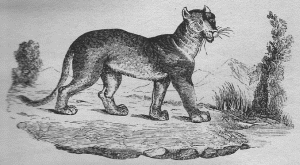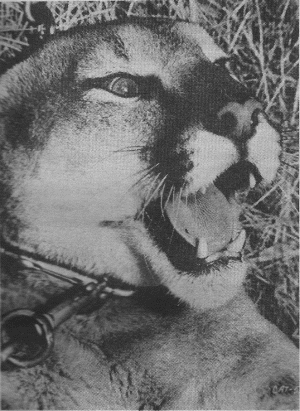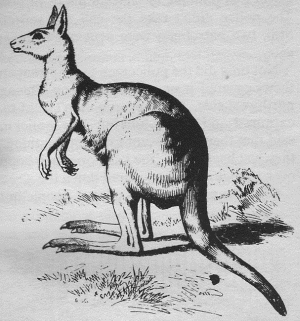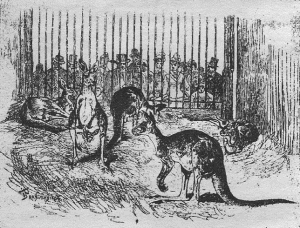Monsters You Never Heard Of (3 page)
Read Monsters You Never Heard Of Online
Authors: Daniel Cohen


Drawing of a puma, or mountain lion. Is it the phantom cat?
Now, about this time you may be thinking, perhaps these people
did
meet real, large cats. The mountain lion or puma is native to the United States. The puma, however, either never lived in, or has long been gone from, the places where these phantom cat reports have been made. Of course, it is always possible that a stray puma could account for some of the reports. But the possibility is a small one.
African lions, tigers, and black panthers are not at all native to the United States. But what if one escaped from a nearby zoo or circus? Whenever a phantom cat is reported, that suggestion comes up at once. Local authorities always check out the possibility. But escaped lions and tigers are very rare. There is no case in which an escaped animal can be linked to the phantom cat sightings.
Phantom cat sightings are perhaps even more common in Great Britain than in the United States. The best known of these is the Surrey puma or Surrey lion. The thing has been sighted regularly in the district of Surrey since the early 1960s. The sightings have been so frequent that one local newspaper complained recently about the "summer ritual of puma spotting."
Usually the Surrey puma has been reported as a large growling and menacing creature. But there is one odd report in which the creature is said to have behaved like—well, like a real pussycat. On September 1, 1966, a woman was walking through a thistle patch in Hampshire (near Surrey). She stepped on the tail of a puma. The animal reared up on its hind legs and struck out at her with both its paws. The woman was not frightened. She picked up a stick and hit the creature on the nose. That so frightened the beast that it ran up a tree. The woman went for help, but when she came back the thing was gone.

The Surrey puma is Britain's most persistent phantom animal. This is a real puma.
On October 14, 1977, a group of workers near Reigate in Surrey saw the thing repeatedly. One of them even managed to take a picture of it. But the creature was too far away for a good picture. It might have been a puma in the photograph. On the other hand, it might only have been a large house cat.
The Surrey puma has never been found. But since it seems to be a regular visitor, it will almost certainly be back again.
Not to be outdone, the district of Nottingham has its own phantom cat. It is called the Nottingham lion.
The story of the Nottingham lion began early in the morning of July 29, 1976. Two milkmen were making their rounds near the entrance to the Nottingham airport. They both saw what they were sure was a lion ". . . its head down and its long tail had a bushy end. It was walking slowly away from us."
They watched it walk around the edge of a field and then called the police. The story got in the newspapers. Over the next week or so there were sixty or more sightings of the Nottingham lion.
The police checked all the zoos and private animal collections within a hundred miles. No one had lost a lion. A massive search was carried out. Dogs and even a helicopter were used in the search.
At first, the police were quite sure there was a loose lion. But as the search went on and they found nothing, they became discouraged. Finally, the police became convinced that the whole thing was a mistake.
It wasn't a real lion at all. It was just another one of the world's phantom cats.
America is not only infested by phantom cats, it also has phantom kangaroos. Mysterious kangaroos have regularly been reported hopping around various parts of the United States for nearly a century now.
The first known account of a phantom kangaroo comes from the town of New Richmond, Wisconsin, in 1900. There, a Mrs. Glovet said that she saw a kangaroo hopping through a neighbor's backyard in the middle of a storm.
Local people remembered that the year before a circus stopping in the town had nearly been destroyed by a tornado. At first, everyone assumed that the kangaroo was an escaped circus animal. But the circus owners denied that they had lost a kangaroo. In fact, they said they never even owned a kangaroo. Besides, it is unlikely that any kangaroo could have survived a Wisconsin winter.
That same year, in Mays Landing, New Jersey, a woman named Amanda Sutts saw "this thing that looked like a kangaroo. It wasn't such a big animal it was about the size of a small calf and weighed about 150 pounds." Mrs. Sutts thought she had seen the famous Jersey Devil. If you will recall, the Jersey Devil was often described as looking like a kangaroo. When a showman wanted to display a phony Jersey Devil, he used a kangaroo with wings attached to its back.
In January, 1934, a strange creature was seen in the small community of South Pittsburgh, Tennessee. Reverend W. J. Handcock said, "It was fast as lightning and looked like a giant kangaroo running and leaping across the field."
The thing may have looked like a kangaroo, but it didn't act like one. It was said to have killed and eaten a large dog. There were also reports that the thing had killed and eaten a number of chickens. A search was organized to find this killer kangaroo, but, as usual, the searchers found nothing.
In January, 1949, Louis Staub was driving his bus outside of Grove City, Ohio. He saw something strange in his headlights.
"It's about 5 1/2 feet high, hairy and brownish in color. It had a long pointed head. It leaped a barbed-wire fence and disappeared. It looked like a kangaroo but it appeared to jump on all fours. I'm certain it wasn't a deer."
For many years children in the area of Coon Rapids, Minnesota, reported seeing "a very big bunny." Sometimes the "bunny" was as tall as they were. A woman named Barbara Battmer said that she got a very clear view of two of the creatures hopping through the woods. She said they were not bunnies at all, they were kangaroos.

Phantom kangaroos have been reported in many places in the Midwest.
In most of these reported close encounters with kangaroos, the creature seems pretty harmless. But if you corner it, and try to capture it, then it can turn nasty. At least, that is what a couple of Chicago policemen said in 1974.
Early on the morning of October 18, 1974, a man called the police. He reported that a kangaroo was jumping around on his front porch. The police didn't take the call too seriously. Still, two patrolmen were sent out to investigate.
Not only did the policemen see the kangaroo, they cornered it up a dark alley on Chicago's northwest side. The kangaroo didn't want to be captured and began kicking. The policemen said that they didn't want to shoot the thing, so they just backed off. The kangaroo then hopped over a fence and disappeared down the street.

A kangaroo in a zoo is not very frightening. A phantom kangaroo is another matter.
Over the next few days a lot of people in the area reported a kangaroo. A newsboy selling papers on a corner turned around and saw a kangaroo standing just a few feet away. "He looked at me, I looked at him, and then away he hopped," the boy said.
The Chicago police got a lot of calls from people who said that the kangaroo was out in their backyards rummaging through their garbage cans. Most of these calls were probably the result of mistaken identity. People heard something—a dog or cat or raccoon rummaging around in the garbage. But with all the kangaroo excitement they assumed it was the kangaroo, and called the police.
The newspapers didn't take the whole thing too seriously. They reported the kangaroo's doings under such headlines as KANGAROO STAYS A JUMP AHEAD OF THE POLICE. But still, people kept right on reporting the thing. Not only that, it began to look as if there was more than one kangaroo around.
While kangaroo sightings continued on Chicago's northwest side, people also began reporting the thing in towns to the west of Chicago.
On the evening of November 2, three young men were driving along Shafer Road in Piano, Illinois. Plano is about fifty miles west of Chicago. They nearly hit the thing.
"We almost ran over it," one of them said. "It jumped onto the road about twenty feet ahead of us . . . It landed on the road near the intersection with the main road and there was no traffic. It sat up on its haunches as kangaroos do, and then jumped over a fence about five feet high and disappeared into the woods."
At almost the same time a couple walking along a Chicago street spotted what they thought was a large dog. Only after it hopped away did they realize it was the kangaroo.
A man in Rensselaer, Indiana, saw the thing on the morning of November 12. It hopped out of a cornfield and up to the drugstore in which he was working. Then it hopped down the street and off into another cornfield. The sighting touched off a search, but no trace of the beast was found.
The man said, "I hope some farmer or somebody else sees it or everybody'll think I'm a nut. But it was a kangaroo . . . I know it was." Within a few days several other people reported seeing the kangaroo in the same area.
By the end of November, the great kangaroo flap had died down. But sightings started up again in Illinois in 1975 and 1976. And in 1976 a Colorado policeman was checking out a kangaroo report, and said that he spotted the creature around some clay pits near Golden, Colorado. As usual, it got away.
Every time there is a rash of kangaroo sightings reporters call the local zoo. Zoo directors get pretty tired of saying that none of their kangaroos have escaped.
There was a 1968 kangaroo flap in Ohio. The director of the Cincinnati Zoo told reporters, "I doubt there's a kangaroo around here on the loose. We had a kangaroo story about two years ago. Never found one. Down the years we've chased after reported black leopards, panthers, and even a polar bear. Anyone seeing the kangaroo, which I doubt exists, should try to keep it in sight and call the zoo."
Dartmoor is a rather wild and remote part of England. The people of Dartmoor have many legends about headless ghosts and spectral hounds. Most of these legends are centuries old. But not all of the strange tales go back hundreds of years. Some are fairly recent. One of the most mysterious is the story of the Hairy Hands.
